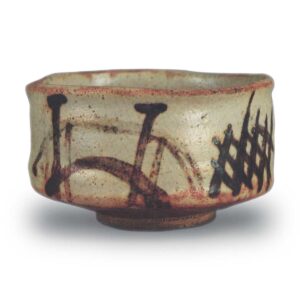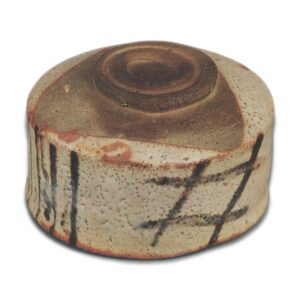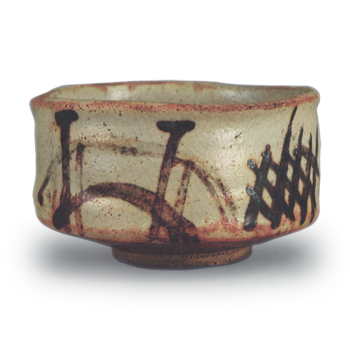

Height: 7.2-7.5cm
Diameter: 12.2-12.7cm
Outer diameter of foot ring: 6.1-6.3cm
Height of foot ring: 0.7cm
The name Sumiyoshi is probably a reference to the bridge depicted on the body of the tea bowl, which is thought to be a bridge at the Sumiyoshi Shrine. It is a small Shino tea bowl, and the overall feel of the work is light and airy, making it a tea bowl that is suitable for drinking light tea.
The clearly defined double foot ring is perhaps a little too innocent, but it is a straightforward work that blends well with the incomparably soft clay taste.
The shape of the foot ring and the body from the waist down is also gently curved, and the body from the waist to the rim is also gently curved, and the wheel marks are barely visible, leaving almost no trace of the use of a spatula.
The slightly upturned rim is typical of Shino ware, and the rim is gently curved.
There are pictures of bridges, cypress trees, calendars and knowledge on the four sides of the body, but it is not clear whether there was any particular meaning to the arrangement of these. It seems that the bridges and calendars are the main theme, and the cypress trees and well frames are secondary designs, but it is an interesting combination of designs nonetheless. The coloring of the iron pigment, or oni-ita, is extremely vivid, and the glaze is particularly white and soft, making it even more beautiful. The fire-colored glaze that appears in the thin parts of the glaze around the rim and waist is also pleasing, as the white glaze gives it a subtle reddish hue, adding a softness to the overall appearance. There are quite a few Shino tea bowls that depict bridges, but this particular tea bowl is thought to have been given the name “Sumiyoshi” because the Shino glaze and iron painting were particularly vivid.
The name “Sumiyoshi” is written in silver powder characters on the lid of the black lacquered inner box. The author is unknown, but the style of the writing is similar to that of the calligraphy of the Izumo region. On the reverse of the lid, there is a small piece of colored paper sprinkled with sand on which is written “Gojo-bashi Shino, Inoue family heirloom”, and the author, Masuda Don’o, added the postscript “Gojo-bashi”.



